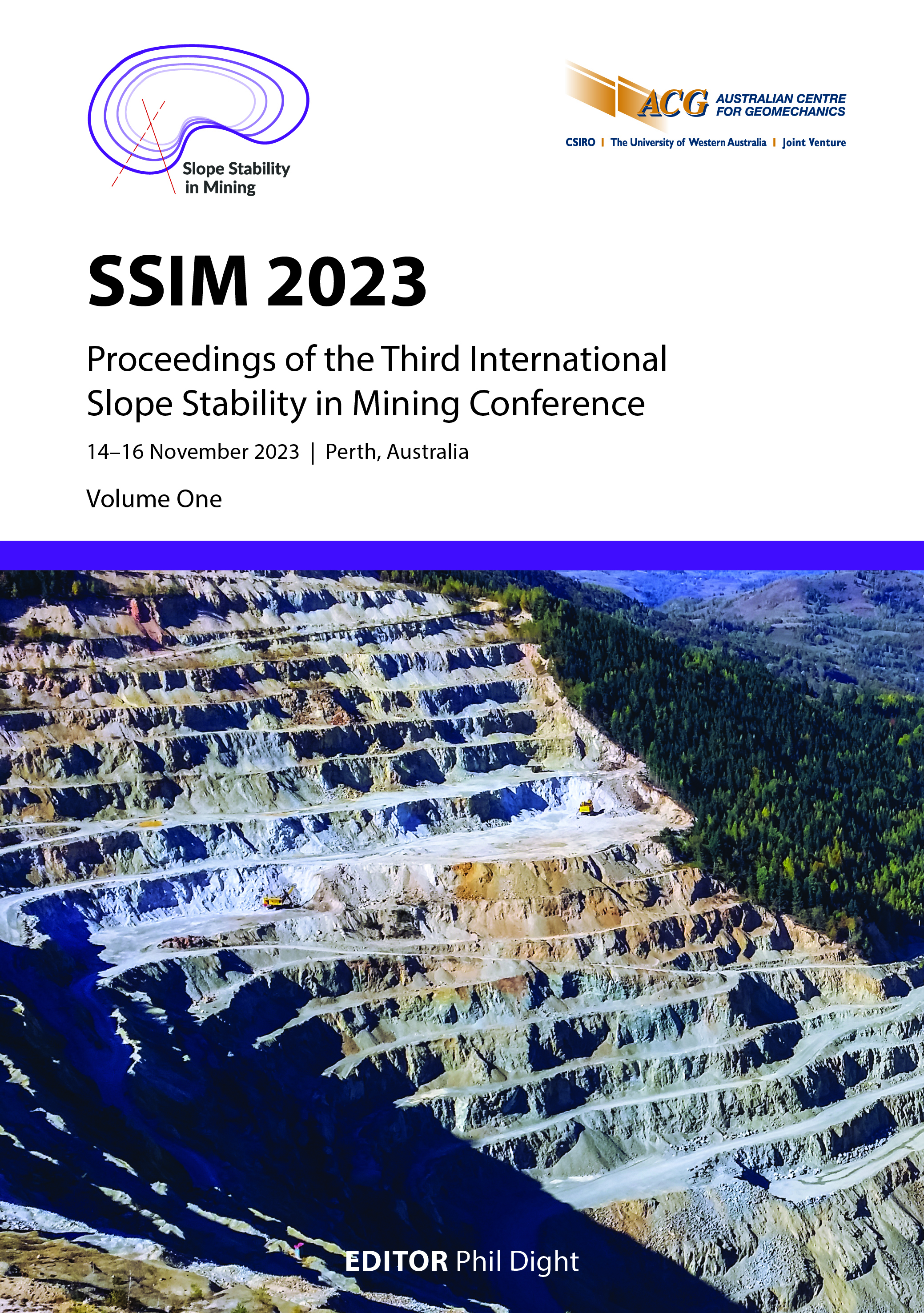Improvement of blasting practices to minimise wall damage at Bozshakol copper mine

|
Authors: Adiyansyah, B; Abzhanov, A; Chapman, D; Bar, N; Caratti, J; Cebrian, B |
DOI https://doi.org/10.36487/ACG_repo/2335_39
Cite As:
Adiyansyah, B, Abzhanov, A, Chapman, D, Bar, N, Caratti, J & Cebrian, B 2023, 'Improvement of blasting practices to minimise wall damage at Bozshakol copper mine', in PM Dight (ed.), SSIM 2023: Third International Slope Stability in Mining Conference, Australian Centre for Geomechanics, Perth, pp. 595-616, https://doi.org/10.36487/ACG_repo/2335_39
Abstract:
Wall damage in large open pit mines is often induced by adjacent blasting activities as a consequence of improper blast design considerations on unforeseen geotechnical conditions. Post-blast damage may vary from slight to severe levels, which are represented by the presence of tension cracks to significant back-break causing crest deterioration or, even worse, loss of the berm itself. Wall control blasting practice is essential in minimising the effect of wall damage so as to reduce geotechnical risks related to rockfall potential, single to multi-bench stability and, less frequently, overall pit wall stability. On some occasions, associated risks may have the potential to impact on critical mine infrastructure such as long-term haulage ramps. Significant economic costs are associated with remediation works required to mitigate rockfall risks, which may range from support measures for rockfall containment to mine design changes and deviations from the mine schedule that typically result in either additional waste removal and ore deferral or sterilisation. This paper discusses the improvement of wall control blasting practices at Bozshakol open pit mine, located in Kazakhstan, Central Asia. It particularly focuses on trim blasting and pre-splitting to minimise wall damage by considering the effects of vibration and blast energy factors within various geotechnical domains. Input of geotechnical information including rock mass characteristics and geological structures also plays an important role for proper wall control blast design considerations. Vibration monitoring is also carried out to assess ground vibration levels expressed by peak particle velocity and establishing site-specific correlations for recommending maximum charge weight per delay. Despite prioritising for wall protection purposes, blasting also needs to achieve a level of fragmentation that supports efficient and productive mining rates. With collaborative interdisciplinary efforts, it is expected that fragmentation needs will be met while achieving final wall design within the tolerance of toe-crest position, bench face angle and berm width while minimising wall disturbance so as to provide a more reliable mine plan.
Keywords: wall control, blasting, blast design, blast vibration, vibration monitoring
References:
Alejano, LR, Pons, B, Bastante, FG, Alonso, E & Stockhausen, HW 2007, ‘Slope geometry design as a means for controlling rockfalls in quarries’, International Journal of Rock Mechanics and Mining Sciences, vol. 44, no. 6, pp. 903–921.
AMC 2010, Feasibility Study Report for Kazakhmys, Section 5 – Geology and Mineral Resources, unpublished report, AMC Consultants Pty Ltd, Melbourne, pp. 6–9.
Bar, N, Cobian, JC, Diaz, C, Bautista, MM, Mojica, B, Coli, N, … & Lopes, L 2022, ‘Brittle and ductile slope failure management’, Proceedings of Slope Stability 2022, Tucson.
Bar, N, Nicoll, S & Pothitos, F 2016, ‘Rock fall trajectory field testing, model simulations and considerations for steep slope design in hard rock’, in PM Dight (ed.), APSSIM 2016: Proceedings of the First Asia Pacific Slope Stability in Mining Conference, Australian Centre for Geomechanics, Perth, pp. 457–466,
Cebrian, B 2022a, Drilling and Blasting Challenges September 2022 KAZ Minerals Bozshakol, unpublished report, Blast Consult S.L., Madrid.
Cebrian, B 2022b, Wall control Drill and Blast Optimization Report, unpublished report, Blast Consult S.L., Madrid.
Duvall, WI & Fogelson, DE 1962, Review of Criteria for Estimating Damage to Residences from Blasting Vibrations, technical report, US Department of the Interior, Bureau of Mines.
Haile, A, Ross, D, Maldonado, A, Neyaz, M & Rajbhandari, C 2020, ‘BHP Western Australia Iron Ore geotechnical open cut slope design system: a simple pragmatic process for slope risk decisions’, in PM Dight (ed.), Slope Stability 2020: Proceedings of the 2020 International Symposium on Slope Stability in Open Pit Mining and Civil Engineering, Australian Centre for Geomechanics, Perth, pp. 415–426,
Hoek, E & Karzulovic, A 2000, ‘Rock mass properties for surface mines’, in WA Hustralid, MK McCarter & DJA van Zyl (eds), Slope Stability in Surface Mining, Society for Mining, Metallurgical and Exploration, Littleton, pp. 59–70.
Holley, K, McKenzie, C & Creighton, A 2003, ‘Striking a balance between blasting and geotechnical issues’, Fifth Large Open Pit Mining Conference, Kalgoorlie.
Kudryavtsev, YuK 1996, ‘The Cu-Mo deposits of Central Kazakhstan’, in Shatov, Seltmann, Kremenetsky, Lehmann, Popov & Ermolov (eds), Granite-Related Ore Deposits of Central Kazakhstan and Adjacent Areas, INTAS-93-1783 project, St. Petersburg, pp. 119–145.
Paul Singh, S & Lamond, RD 1994, ‘Investigation of blast damage and underground stability’, 12th Conference on Ground Control in Mining, Laurentian University, Sudbury.
Rzhevsky, V & Novik, G 1984, Osnovy Fiziki Gornykh Porod, NEDRA Publishing, Moscow, pp. 69–74.
Read, J & Stacey, P 2009, Guidelines for Open Pit Slope Design, CSIRO Publishing, Melbourne.
Shen, P, Pan, H, Seitmuratova, E, Yuan, F & Jakupova, S 2015, ‘A Cambrian intra-oceanic subduction system in the Bozshakol area, Kazakhstan’, Lithos, vol. 224–225, pp. 61–77.
Silva, J, Jenks, P & Sharon, R 2016, ‘Improved signature hole analysis for blast vibration control in open pit mines’, Proceedings of the 50th US Rock Mechanics/Geomechanics Symposium, American Rock Mechanics Association, Alexandria.
Tektonik Consulting Limited 2022, Bozshakol Cu deposit, Kazakhstan: Structural geological model to support Geotechnical and Hydrogeological Planning, unpublished report, Tektonik Consulting Limited, South Wales.
© Copyright 2024, Australian Centre for Geomechanics (ACG), The University of Western Australia. All rights reserved.
View copyright/legal information
Please direct any queries or error reports to repository-acg@uwa.edu.au
View copyright/legal information
Please direct any queries or error reports to repository-acg@uwa.edu.au

